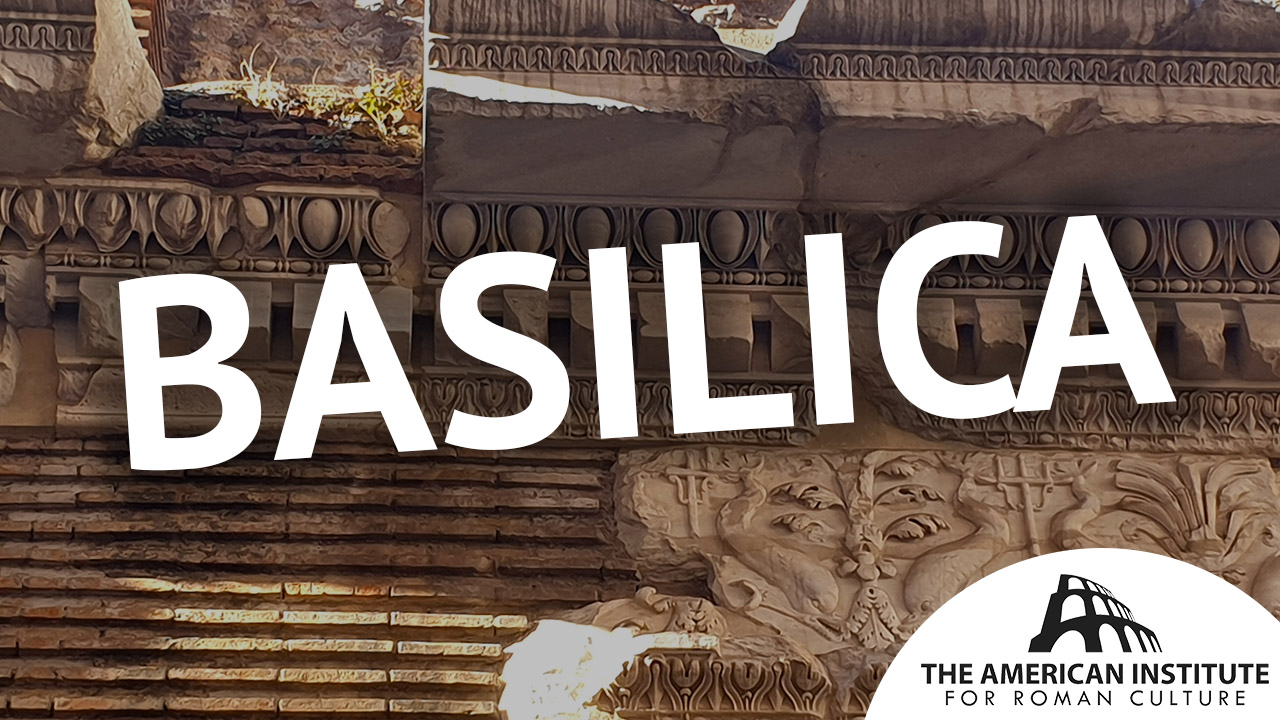Start with our video overview:
In Ancient Rome, basilicas were versatile and monumental structures that served the civic, judicial, and religious needs of society. Designed as long rectangular buildings featuring a large central space (called a nave), and flanked on either side by aisles, basilicas were centers of public life. Over the centuries their purpose evolved dramatically – from marketplaces and courtrooms to Christian churches. Their design, functionality, and legacy offer a fascinating window into the ingenuity of Roman builders and the transformation of the Roman world.
Origins and Early Development
While the exact origin of basilicas remains unknown, their architectural roots may lie in earlier Greek and Hellenistic structures. The term basilica is derived from Ancient Greek, and roughly translates to “home of the basileus (king).” Basilicas may have been inspired by the grand audience halls of Hellenistic palaces, or by Greek stoas, long covered porticos used as meeting spaces and markets.
The first basilica, the Basilica Porcia, was built in 184 BCE by Cato the Elder. Positioned near the Roman Forum, it became a hub for public gatherings, legal proceedings, and commerce. Two more basilicas, the Basilica Aemilia and Basilica Sempronia, were constructed near the forum in the following decades. Under Augustus, these early basilicas were transformed into architectural marvels. The Basilica Aemilia was rebuilt into such an elegant structure that Pliny the Elder described it as one of the most beautiful buildings in the world.
Imperial Basilicas: Symbols of Power and Prosperity
During the imperial period, Roman basilicas grew larger and more ornate. The Basilica Ulpia, built in the 2nd century CE under Trajan, was a masterpiece of Roman engineering. With its immense size, gilded statues, and large apses, it served as a powerful symbol of Trajan’s political and military might.
Even more impressive was the Basilica of Maxentius. Completed in 312 CE, it was the largest basilica ever built in Rome. At 262 feet long, 82 feet wide, and 115 feet in height, it rivaled the size of Rome’s largest bath complexes. Its innovative use of concrete and vaulted ceilings pushed architectural boundaries, creating a space that was as awe-inspiring as it was functional.
Basilicas were not confined to Rome. They could be found in cities across the empire, reflecting Romanization in the provinces. Impressive remains of basilicas can be found at Leptis Magna in modern-day Tunisia and at Baelo Claudia in modern-day Spain. In the Hellenized East, basilica construction was influenced by Greek stoas. This can be seen in the Basilica at Ephesus, with its open portico and elongated design. One of the most remarkable basilicas outside of Italy is the Aula Palatina in Trier, Germany. Built by Constantine in the early 4th century CE as part of a palace, it has been incredibly well-preserved.
Christian Transformation
The reign of Constantine marked an important turning point for Roman basilicas. Following the legalization of Christianity in 313 CE with the Edict of Milan, Constantine initiated a wave of church construction across the empire. He used the basilica as a template for these new churches, as their spacious interiors accommodated large congregations and religious ceremonies.
Under Constantine, construction began on Old Saint Peter’s Basilica, which stood for over a millennium before being replaced by the version that stands today. This monumental church became a prototype for future Christian basilicas, featuring a wide nave, side aisles, and an apse for the altar. While earlier basilicas had been secular spaces for commerce and administration, under Constantine and his successors, basilicas were exclusively associated with Christianity. Their original civic roles were gradually transferred to other public buildings.
Even as the Roman Empire faded, basilicas endured as places of worship. Today, basilicas remain centers of Christianity and their architectural influence can be seen in churches around the world, solidifying their place as one of Ancient Rome’s most lasting and influential legacies.
Bibliography:
- Davis-Marks, Isis. (2021). “Enormous Roman Basilica Dated to King Herod’s Reign Revealed in Israel.” Smithsonian Magazine. https://www.smithsonianmag.com/smart-news/archaeologists-uncover-2000-year-old-roman-basilica-180977926/
- Dumber, Elisha Ann. (2010). “Basilica.” In The Oxford Encyclopedia of Ancient
Greece and Rome (1st ed). - Grout, James. (n.d). “Basilica Ulpia.” University of Chicago. http://penelope.uchicago.edu/~grout/encyclopaedia_romana/imperialfora/trajan/basilica.html
- Krautheimer, Richard. (1967). The Constantinian Basilica. Dumbarton Oaks Papers, 21, 115–140. https://www.jstor.org/stable/1291261
- Müller, Valentin. (1937). The Roman Basilica. American Journal of Archaeology, 41(2), 250–261. https://www.jstor.org/stable/498415
- Perkins, J. B. Ward. (1954). Constantine and the Origins of the Christian Basilica. Papers of the British School at Rome, 22, 69–90. http://www.jstor.org/stable/40310515
- Platner, Samuel. (1929). “Basilicae.” In A Topographical Dictionary of Ancient Rome. Retrieved from: https://penelope.uchicago.edu/Thayer/E/Gazetteer/Places/Europe/Italy/Lazio/Roma/Rome/_Texts/PLATOP*/basilicae.html
This content is brought to you by The American Institute for Roman Culture, a 501(C)3 US Non-Profit Organization.
Please support our mission to aid learning and understanding of ancient Rome through free-to-access content by donating today.
Cite This Page
Cite this page as: Darius Arya, The American Institute for Roman Culture, “Basilica (General),” Ancient Rome Live. Last modified 12/17/2024. https://ancientromelive.org/basilica-general/
License
Created by The American Institute of Roman Culture, published on 11/11/2019 under the following license: Creative Commons: Attribution-NonCommercial-ShareAlike. This license lets others remix, tweak, and build upon this content non-commercially, as long as they credit the author and license their new creations under the identical terms. Please note that content linked from this page may have different licensing terms.



